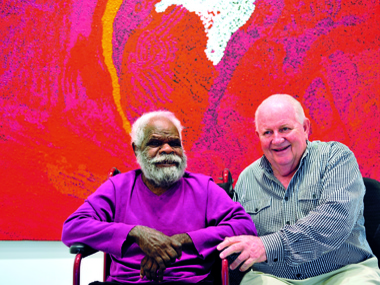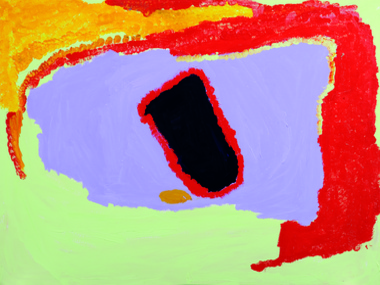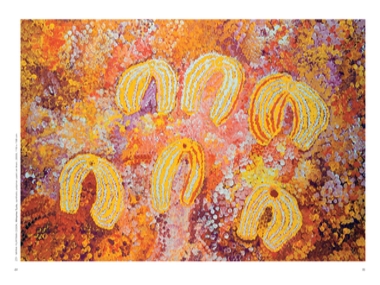PAT CORRIGAN, COLLECTOR

Artist Tommy Watson with Pat Corrigan. Courtesy of Agathon Galleries.
Jeremy Eccles | 30.01.13
Author: Jeremy Eccles
News source: Review
In the torrent of art books with an Indigenous flavour that were published last year, one stands out for the sheer exuberance of its art – and the quality of its reproduction : Power + Colour/New Painting from the Corrigan Collection of 21st Century Aboriginal Art.
A mouthful, yes. But important to distinguish from New Beginnings, the first volume of works from Pat Corrigan's 1500-strong collection of Aboriginal art, which lacked, the collector now feels, “a real concentration on the art I love from the APY Lands”. Given that Corrigan has actually only been in the market for Aboriginal art since 2003 – less than 10 years – and he set himself an absolute rule that he wouldn't buy art from before 2000, it surely reveals a man in a hurry to both buy what he loves the look of, and promote it.
Not promote himself, as some cynics might assume from the prominence of the Corrigan name. In fact, I see a distinct age link between collector and artists; for many of his chosen artists were also in their 70s when they first came to canvas – a late flowering of a talent that still amazes Corrigan. “How do each of these old people pick up a brush for the first time and blaze away with his or her own distinct style”, the now-80 year old wondered.
But just as the artists have been developing their visual acuity through the detailed observation needed to survive in the desert and the matching want to describe their physical and spiritual surroundings to others in the tribe, often using the aide-memoire of a finger in the sand, so Corrigan has been in training for this phase of his collecting life for a long time. As a 9 year old, he lost all the possessions of a gilded Oriental childhood when the Japanese threw him into a Hong Kong prison camp. Since his release, he's moved through toy soldiers, books and book-plates, jazz records (7000 LPs are now in the National Archive) and non-Indigenous Australian art. It, rather than the newly espoused APY art now surrounds him in his Sydney flat – though he assures me that's just the current hang. Significantly, the only Aboriginal canvas that makes it into this hang is “just the right” Daniel Walbidi which he says he spent three years tracking – somewhat belying words such as “mercurial” and “an urgent and unbridled enthusiasm” used by Jane Raffan in her essays that open Power + Colour, which suggest more speed than intensity in the collecting.
Mind you, I wouldn't want to be in the way of Pat Corrigan at the opening of show such as Desert Mob when he's spotted a work he likes the look of. For it's the look, not the story or the perceived spirituality that gets the Corrigan adrenaline flowing. And Alice Springs is as far as he goes in terms of “going bush” to communities or meeting the artists – unlike collectors such as the Lavertys – Colin and Liz – who bought so much in remote community art centres (and are now slimming down their collection with a small sale at Bonhams in March).
The Lavertys were, of course, involved in the Indigenous art world since 1988 when they enjoyed a 'Road to Damascus' experience at an exhibition during the Brisbane Expo. Part of Corrigan's motivation in restricting his collecting to post-2000 was the sense that he could never backdate his collection to compete with their Rovers and Emilys. But a study of the Lavertys second edition of Beyond Sacred – their record of collection - reveals that their enthusiasm for the APY art that has really only flowered since 2000 is underwhelming beside his. There's nothing to reflect Corrigan's heartfelt, “Tommy Watson just blew me away”, and no sign at all Wingu Tingima, the other benchmark APY artist he first saw in 2004 at the NGV's Colour Power show – Aboriginal Art post-1984, which really began the Corrigan quest.
So Jane Raffan's claim that APY art has become “the dominant” Aboriginal art style since then is just a tad hyperbolic. Yes – APY artists like Jimmy Donegan and Dickie Minyintiri have justifiably won several NATSIA Awards in recent years. But that's rarely reflected in selections like the NGA's Second Triennial (or its Collection hang), Hetti Perkins' Art + Soul or the WA Art Gallery's Indigenous Award shows. And our auction houses seem almost equally unenthused – only Tommy Watson making regular appearances (except at Bonhams – which did, however put a splendid Tjungkara Ken on the cover of its sale of the Bill Nuttall and Annette Reeves Superannuation Collection).
Could they all be in denial of that white hot brush-work reflecting an urgency to tell each story before death takes an artist whose brief flowering on canvas may well have only begun in her or his 70s? It's certainly not as neat as Papunya Tula work. But, as Pat Corrigan noted at the NGV in 2004, “This is all different!”.
And Corrigan's approach in Aboriginal art is different too. He rigidly restricts his judgements to the look of a painting – no story, no politics and rarely a personal relationship with these remote artists; Watson is obviously an exception. It means he has few relationships either with community art centres, who, he believes, “prefer selling to State galleries” - buying instead from dealers who know his taste and are prepared to make their first offers to him by email, and occasionally at auction – though he doesn't trust the photographs in their catalogues. His secret is an ability to make quick decisions.
And all this has had an effect on the book. While the Lavertys' books set out to make the case for Aboriginal art as 'contemporary art' per se, Corrigan's simply offers his paintings to the world in alphabetical order, with no commentary beside them. 'Just look at that colour', he's saying. Then there are notes at the end about artworks and artists from Jane Raffan. Ironically, the absence of commentary with the paintings is political; it's how most institutions now present Indigenous art, when, I'd argue, most viewers want to delve a whole lot deeper. There's also irony in the fact that Corrigan is so true to his colour priority that the most pictured artist in the book isn't actually from the APY Lands – it's Sally Gabori from Mornington Island. “She's half way between Rothko and Pollack”, he enthused on an ABC Radio interview.
So the book flows from Spinifex man Mark Anderson to Balgo's Lucy Yukenbarri via the late Martu leader, Rita Simpson of Punmu, WA, Akay Koo'oila of Aurukun on Cape York and Stumpy Brown from Mankaja in The Kimberley. “I should have bought more by Rita Simpson while she was alive”, regrets Corrigan, “and Mitjili Gibson. But I'm an impulse collector – not an organised disciplined man with an agenda”. As a result of which Corrigan has a cull every year – donating those looking less good on second sight to a range of organisations. There are also at least 600 works on loan to institutions such as Bond University and UTS, SBS, and the regional galleries of Australia, for “services to whom” he's already received an AM.
But all this is a hobby, he insists. The octogenarian still works in the business that made him rich, now at the logistical cutting edge, delivering the fruits of internet shopping. But “sharing the joy of collecting” means he's taking time out in coming weeks in both Brisbane and Sydney. Kevin Rudd, no less, will be launching Power + Colour at the GOMA Store of the Queensland Art Gallery on Saturday 9th Feb at 10.30am; and the AGNSW Society members get a tour of Corrigan's art-packed flat on Tuesday 12th Feb at 6.30pm.
Or you could just buy the book for $125!
URL: Palgrave MacMillan
Share this:
»  del.icio.us
»
del.icio.us
»  Digg it
»
Digg it
»  reddit
»
reddit
»  Google
»
Google
»  StumbleUpon
»
StumbleUpon
»  Technorati
»
Technorati
»  Facebook
Facebook
Contact Details

Mirdidingkingathi Juwarnda Sally Gabori, 'Outside Story Place', 2006 Synthetic polymer paint on linen 121 x 91cm. Courtesy of the artist and Mornington Island Arts & Craft

Myra Yurtiwa Cook, 'Minyma Tjuta', Synthetic polymer pain on linen, 2008 118 x 198cm. Courtesy of the artist and Irrunytju Arts Centre
Further Research
Artists: Akay Koo'oila | Daniel Walbidi | Jimmy Donegan,Dickie Minyintiri | Lucy Yukenbarri | Mark Anderson | Mitjili Gibson | Muni Rita Simpson | Myra Cook | Sally Gabori | Stumpy Brown | Tjungkara Ken | Tommy Watson | Wingu Tingima
News Tags: Jane Raffan | Kevin Rudd | Macmillan Books | Pat Corrigan | Tommy Watson
News Archive
- 11.10.17 | RETURN OF MUNGO MAN
- 10.10.17 | TARNANTHI 2017
- 11.08.17 | Natsiaas 2017
- 08.08.17 | ABORIGINAL ART ECONOMICS
- 02.08.17 | SCHOLL'S NEXT MOVE
- 20.07.17 | APY ART DOMINATES THE WYNNE
- 17.07.17 | Anangu Artist Wins $100,000 Prize
- 14.07.17 | The End of AAMU
- 13.07.17 | YOU ARE HERE
- 11.07.17 | ART ACROSS THE COUNTRY
- 11.07.17 | TARNANTHI IN OCTOBER
- 05.07.17 | TJUNGUṈUTJA - from having come together
- 02.07.17 | BENNELONG
- 27.06.17 | JIMMY CHI
- 23.06.17 | Blak Markets at Barangaroo
Advertising

